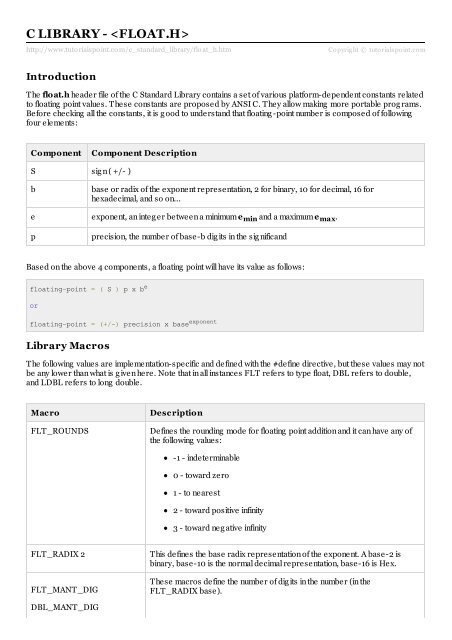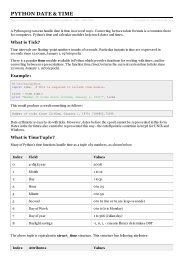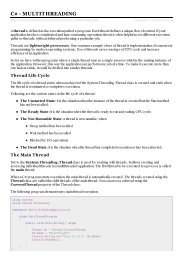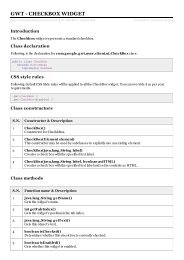PDF Version - Tutorials Point
PDF Version - Tutorials Point
PDF Version - Tutorials Point
You also want an ePaper? Increase the reach of your titles
YUMPU automatically turns print PDFs into web optimized ePapers that Google loves.
C LIBRARY - <br />
http://www.tuto rialspo int.co m/c_standard_library/flo at_h.htm<br />
Copyrig ht © tutorialspoint.com<br />
Introduction<br />
The float.h header file of the C Standard Library contains a set of various platform-dependent constants related<br />
to floating point values. These constants are proposed by ANSI C. They allow making more portable prog rams.<br />
Before checking all the constants, it is g ood to understand that floating -point number is composed of following<br />
four elements:<br />
Component<br />
Component Description<br />
S sig n ( +/- )<br />
b<br />
base or radix of the exponent representation, 2 for binary, 10 for decimal, 16 for<br />
hexadecimal, and so on...<br />
e exponent, an integ er between a minimum e min and a maximum e max .<br />
p<br />
precision, the number of base-b dig its in the sig nificand<br />
Based on the above 4 components, a floating point will have its value as follows:<br />
floating-point = ( S ) p x b e<br />
or<br />
floating-point = (+/-) precision x base exponent<br />
Library Macros<br />
The following values are implementation-specific and defined with the #define directive, but these values may not<br />
be any lower than what is g iven here. Note that in all instances FLT refers to type float, DBL refers to double,<br />
and LDBL refers to long double.<br />
Macro<br />
FLT_ROUNDS<br />
Description<br />
Defines the rounding mode for floating point addition and it can have any of<br />
the following values:<br />
-1 - indeterminable<br />
0 - toward zero<br />
1 - to nearest<br />
2 - toward positive infinity<br />
3 - toward neg ative infinity<br />
FLT_RADIX 2<br />
FLT_MANT_DIG<br />
This defines the base radix representation of the exponent. A base-2 is<br />
binary, base-10 is the normal decimal representation, base-16 is Hex.<br />
These macros define the number of dig its in the number (in the<br />
FLT_RADIX base).<br />
DBL_MANT_DIG
LDBL_MANT_DIG<br />
FLT_DIG 6<br />
These macros define the maximum number decimal dig its (base-10) that<br />
can be represented without chang e after rounding .<br />
DBL_DIG 10<br />
LDBL_DIG 10<br />
FLT_MIN_EXP<br />
These macros define the minimum neg ative integ er value for an exponent in<br />
base FLT_RADIX.<br />
DBL_MIN_EXP<br />
LDBL_MIN_EXP<br />
FLT_MIN_10_EXP -37<br />
These macros define the minimum neg ative integ er value for an exponent in<br />
base 10.<br />
DBL_MIN_10_EXP -37<br />
LDBL_MIN_10_EXP -37<br />
FLT_MAX_EXP<br />
These macros define the maximum integ er value for an exponent in base<br />
FLT_RADIX.<br />
DBL_MAX_EXP<br />
LDBL_MAX_EXP<br />
FLT_MAX_10_EXP +37<br />
These macros define the maximum integ er value for an exponent in base 10.<br />
DBL_MAX_10_EXP +37<br />
LDBL_MAX_10_EXP +37<br />
FLT_MAX 1E+37<br />
These macros define the maximum finite floating -point value.<br />
DBL_MAX 1E+37<br />
LDBL_MAX 1E+37<br />
FLT_EPSILON 1E-5<br />
These macros define the least sig nificant dig it representable.<br />
DBL_EPSILON 1E-9<br />
LDBL_EPSILON 1E-9<br />
FLT_MIN 1E-37<br />
These macros define the minimum floating -point value..<br />
DBL_MIN 1E-37<br />
LDBL_MIN 1E-37
Example<br />
The following example shows the usag e of few of the constants defined in float.h file.<br />
#include <br />
#include <br />
int main()<br />
{<br />
printf("The maximum value of float = %.10e\n", FLT_MAX);<br />
printf("The minimum value of float = %.10e\n", FLT_MIN);<br />
}<br />
printf("The number of digits in the number = %.10e\n", FLT_MANT_DIG);<br />
Let us compile and run the above prog ram, this will produce the following result:<br />
The maximum value of float = 3.4028234664e+38<br />
The minimum value of float = 1.1754943508e-38<br />
The number of digits in the number = 7.2996655210e-312

















